|
Classy and Colorful Candy Containers
By Betty MacDuff
What are candy containers?
Candy containers are small toys made of glass that were filled with
tiny candy pellets. The candy is held in the glass by metal strips,
screw caps or cardboard inserts.
Candy containers began in
the late 1800s with the first two documented pieces being shaped
like Independence Hall in Philadelphia and the Liberty Bell, both
dating to the Centennial Exposition in 1876 in Philadelphia, Penn.
By the early 1900s, manufacturing of candy containers was in full
swing. These new glass toys, designed to appeal to children, also
became a collectable for adults, primarily because of the wide range
of designs. The shapes were historical in nature, war-related,
holiday-themed, comic strip characters, animals, doll bottles and
furniture and much more.
After the candy was eaten,
little boys could play with a 3-piece New York Central Train or
Overland Limited; they could run cars, buses and trucks through the
sand, or play cowboys and Indians with a glass gun. War-related
items such as tanks, jeeps, ships and airplanes were certainly in
demand for playing Army. The girls could buy a nursing bottle for
their doll, Flossie Fisher metal and glass furniture for their
dollhouses, telephones, lamps and lanterns, rolling pins, irons, or
cups for drinking.
The holiday designs for
Christmas (Santa Claus), Easter (rabbits, ducks, chickens),
Halloween (jack o'lanterns, pumpkin-headed policemen and witches)
and other special holidays inspired another whole group of
collectors.
|
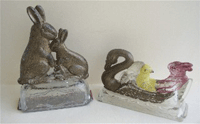
|
Rabbit Family, $1200 and Swan Boat with Rabbit
and Chick, $700.
|
Close inspection of these
glass toys reveals the intricacies of detail that went into the
design. In the early years, a craftsman would create an individual
mold for each design. The glass part of the container was then
either pressed or blown into the mold one at a time, and then after
cooling was hand painted by women. How time consuming!
The Depression stopped
production from 1929 until about 1939. Then manufacture started to
pick up again in 1940. During the war, production was switched to an
automated assembly line, as the demand was so great that factories
couldn't keep up. Thousands could now be made in a day. The scarcity
of metal during this period caused closure material to be changed
from metal to waxed cardboard, cork stoppers and wood. After the
1950s, plastic replaced the glass as a cheaper material. Some of
these later pieces were manufactured with whistles made of plastic
attached to a cardboard tube. Eventually, all manufacture stopped
less than 100 years after it began.
These highly sought after
glass toys were sold at railway stations and 5 & 10 cent stores,
through mail order catalogs, such as Sears & Roebuck and
Montgomery Ward, and at souvenir stands.
Most of the manufacturers
were located in a very small area of Pennsylvania, in Jeanette and
Grapeville, due to the abundant supply of natural resources needed
in the manufacture of glass. The major manufacturers operating
during the height of the industry from this area were: West Brothers
Co.; T. H. Stough; Westmoreland Specialty Co.; Westmoreland Glass
Co.; Jeannette Glass Co.; Victory Glass Inc.; L. E. Smith; J. H.
Millstein; and J. C. Crosetti Co.
My husband, Leigh, and I
starting collecting candy containers in the early 1970s. Like most
collectors of glass, digging in old dumps was somehow involved at
the inception. In our case, my mother had dug a chicken and a rabbit
in her back yard, and even with cracks, we fell in love with them,
and as they say, "the rest is history."
We enjoyed searching for
them as they were cheap, and having lived in southern New Jersey,
they were plentiful. On a teacher's salary raising four children, we
didn't have a lot to spend. We would go to an antique show, and
after having walked the entire place, we would have to decide which
ones we would buy for the less than $20 we had to spend. Sometimes
that amount got us three or four pieces.
Thirty years later, our
collection numbers 500+ pieces. It is hard to believe that we have
collected that many.
Now retired and living in
Florida, we have to rely on private auctions and online bidding.
Prices today have increased due to the lack of availability, their
fragility, and the increased number of collectors. The bidding
online gets hot and heavy at times when a particularly rare piece is
listed. The prices range anywhere from $25 for the very low end
common ones up to $5,000+ for the hard to find. Here are some recent
prices paid for rare candy containers: country club bus, $2,255;
1920s refrigerator (very rare piece) $6,050; metal bungalow village
building with glass insert $2,090; Statue of Liberty, $7,200; and
kaleidoscope (one of a kind) $22,425. Prices of some common pieces:
1028 locomotive $30; beaded lantern, $25; nursing bottle, waisted,
$30; and telephone, Victory Glass Co. dial type, $40.
The advent of the Internet
has made the world smaller, opening up a worldwide marketplace to
the collector without leaving home. We have since found glass candy
containers from Argentina and Uruguay, Europe and Japan.
The Candy Container
Collectors of America was organized in 1984 to promote candy
container collecting internationally, to educate and inform those
who collect, and to encourage new collectors. The bi-monthly
newsletter, The Candy Gram, provides news and information on candy
containers and related collectibles. Each issue contains
photographs, some unusual or rare. Dues are $25 per year, which
includes receiving the newsletter, The Candy Gram, and eligibility
to attend the annual convention.
For information, contact Jo
Baldwin, Box 1971, Anderson, IN 46018, 765-643-7065, or visit the
club web site: http://candycontainer.org/index.html.
Our thanks to Betty for
this article. You can contact her by email at epmac27@comcast.net or call
her at 352-753-7795 to discuss candy containers.
2003
|
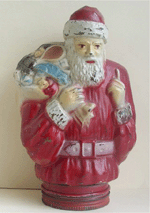
Large
Santa with metal screw-on closure on base from Argentina, $300,
1930s. 8 1/4" high and weighs 1 3/4 lbs. empty.
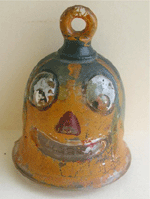
Goblin
Head, $600, ca. 1920, 3 9/16" high.
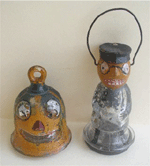
Pumpkin Head Jr. Policeman (r.), $1,200, ca. 1920, 4
5/16" high. Manufacturer not known. Grotesque head with policeman or
fireman hat, goggles, coat and boots.
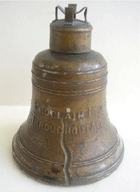
Liberty Bell candy container , $125. Marked
"1776-Centennial Exposition-1876," Croft Wilbur & Co.
Confec-tioners, manufacturer.
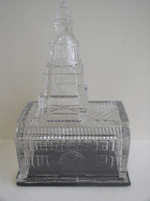
Independence Hall, $350. Souvenir of the Philadelphia
Centennial Exposition of 1876 with a coin slot in roof.
|